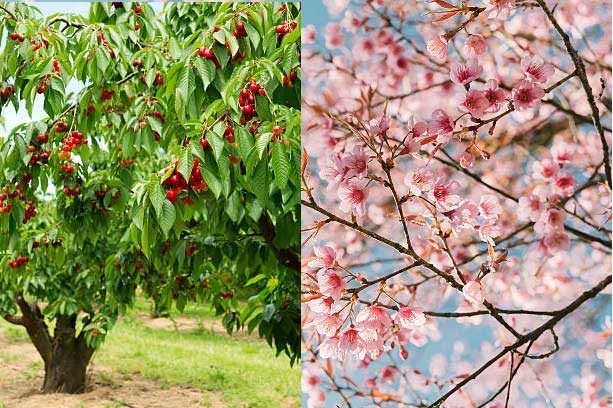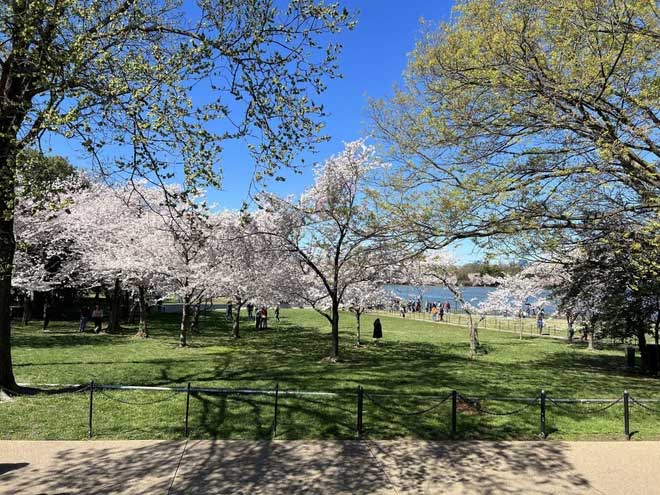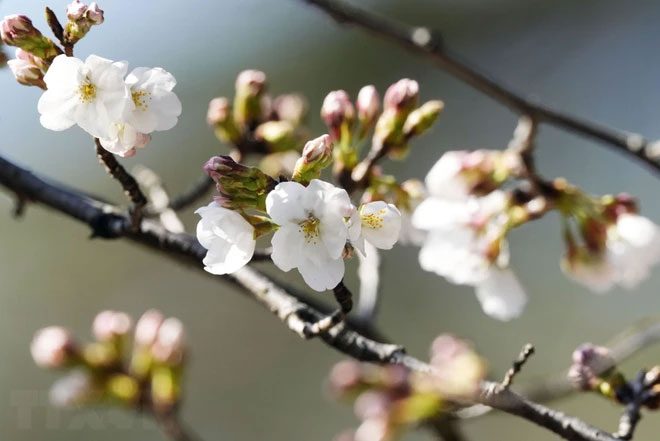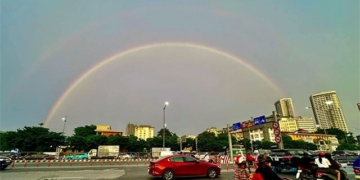As spring arrives, cherry blossoms bloom along the streets of many major cities around the world, creating a breathtaking spectacle that captivates not only tourists but also local residents.
However, not every region is graced with cherry blossoms. For many people, especially in tropical countries, the term “cherry” typically refers to a small fruit with a dark red, glossy skin, often imported from nations that cultivate cherry trees.

Cherry trees and cherry blossom trees. (Source: iStock).
Thus, one might wonder if the enticing cherries we eat come from those densely blooming cherry trees.
On wusa9.com, a local news site in Washington DC, the question was even posed: “Do cherry blossom trees produce cherries?” along with the note: “We think this is a question you might be hesitant to ask, so we will provide the answer.”
The answer provided by the site, referencing information from National Park Service Plant Specialist Matthew Morrison and the Arbor Day Foundation, is: Yes, cherry blossom trees can produce fruit, but it will not be the type of cherries you would want to put on your cake.
Matthew Morrison states that the Yoshino cherry trees surrounding the Tidal Basin in Washington DC were a gift from Japan in 1912. These trees can produce “large, beautiful, and very tasty” cherries.
However, the subsequent generations of cherry trees were not grown from the seeds of the parent trees but were propagated through cuttings. Therefore, they do not bear fruit but only produce flowers. Nonetheless, some cherry trees have exhibited traces of original DNA and may produce tiny fruits.
According to the Arbor Day Foundation, these small berries are an important food source for many small bird species.
Morrison describes: “They are tiny cherries that humans would never want to eat, but local wildlife certainly does. They resemble berries, but have a very large pit and a thin flesh.”
This change is due to human breeding purposes of the trees planted along the Tidal Basin over 100 years ago, aimed at serving human needs rather than those of animals.
“A tree that does not bear fruit will be much cleaner and tidier. That’s why we grow them just for their blossoms,” Morrison explains. He adds that if you want to pick fresh cherries in this area, your only option is to visit a farmer’s market.

Cherry blossoms in full bloom by the Tidal Basin in Washington DC. (Photo: Kieu Trang/TTXVN)
Madison Moulton, a freelance writer specializing in gardening, highlights the notable differences between these two types of trees, with the first distinction stemming from their names: Cherry Tree and Cherry Blossom Tree.
According to this author, while both types of trees share part of the name “cherry” and belong to the same genus Prunus, they are classified into different species. For example, sour cherries are Prunus cerasus, and sweet cherries are Prunus avium. Cherry blossoms include numerous varieties, such as Prunus serrulata or Prunus speciosa, also known as ornamental cherries.
In other words, the “cherry trees” do have flowers, but they are not as vibrant and striking because they focus on producing fruit. Meanwhile, the “cherry blossom trees” do produce fruit, but it is small and not palatable.
Madison also notes that for most of the year, the two types of trees look quite similar. They have comparable leaf shapes and branch structures, differing only slightly in size. Cherry blossom trees are typically one and a half to twice the height of cherry trees, although their canopy coverage is similar.

Cherry blossoms blooming in Tokyo, Japan, on March 14, 2023. (Photo: Kyodo/TTXVN).
They start to differ distinctly during the flowering season. Cherry trees produce flowers with a short lifespan that quickly turn into fruit. These flowers usually have fewer petals and are white or pinkish-red. Subsequently, they are covered by clusters of dark red or deep purple fruit.
In contrast, the flowers of cherry blossom trees bloom for several weeks, showcasing their vibrant beauty. The cherry blossoms come in various colors and shapes, with some even displaying yellow or green hues.
Madison also provides a simple way to distinguish the two types of trees when shopping for them: just check their labels. If the label says ornamental tree, it is a cherry blossom tree. If it’s labeled fruit tree, then it is a cherry tree.


















































